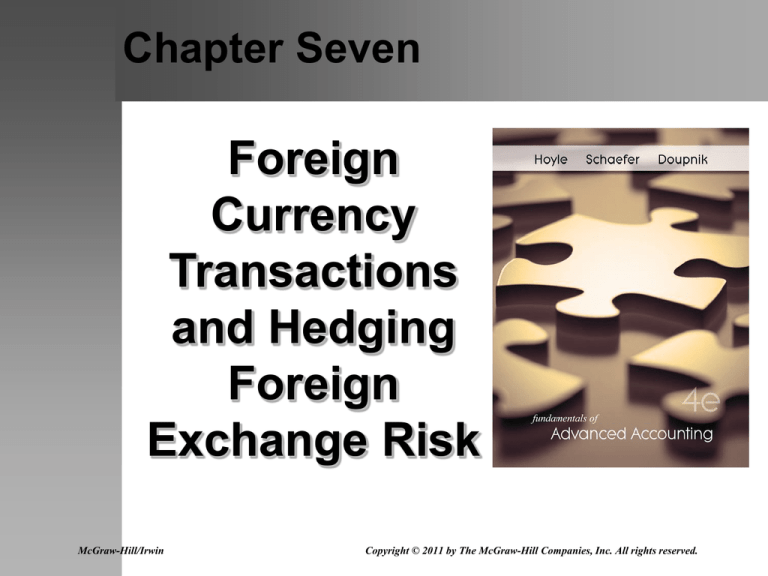
Chapter Seven
Foreign
Currency
Transactions
and Hedging
Foreign
Exchange Risk
McGraw-Hill/Irwin
Copyright © 2011 by The McGraw-Hill Companies, Inc. All rights reserved.
7-2
Foreign Exchange Rates
An Exchange Rate is the cost of one
currency in terms of another.
Rates published daily in the Wall
Street Journal are as of 4:00pm
Eastern time on the day prior to
publication.
The published rates are wholesale
rates that banks use with each other –
retail rates to consumers are higher.
The difference between the rates at
which a bank is willing to
buy and sell currency is
known as the “spread.”
Rates change constantly!!
7-3
Foreign Exchange Rates
Spot Rate
The exchange rate that is
available today.
Forward Rate
The exchange rate that
can be locked in today for
an expected future
exchange transaction.
The actual spot rate at the
future date may differ from
today’s forward rate.
7-4
Foreign Exchange Forward Contracts
A forward contract requires the purchase
(or sale) of currency units at a future date
at the contracted exchange rate.
This forward contract
allows us to purchase
1,000,000 ¥ at a price
of $.0080 US in 30
days.
But if the spot rate is
$.0069 US in 30 days,
we still have to pay
$.0080 US and we
lose $1,100!!
7-5
Foreign Exchange –
Option Contracts
An options contract gives the holder the
option of buying (or selling) currency
units at a future date at the contracted
“strike” price.
An alternative is an
option contract to
purchase 1,000,000 ¥
at $.0080 US in 30
days. But it costs
$.00002 per ¥.
That way, if the spot
rate is $.0069 in 30
days, we only lose
the $20 cost of the
option contract!
7-6
Foreign Currency Option Contracts
A “put” option allows for the sale of
foreign currency by the option holder.
A “call” option allows for the purchase
of foreign currency by the option
holder.
Remember: An option
gives the holder “the
right but not the
obligation” to trade
the foreign currency
in the future.
7-7
Foreign Currency Transactions
A U.S. company
buys or sells
goods or services
to a party in
another country.
This is often called
foreign trade.
The transaction is
often denominated
in the currency of
the foreign party.
How do we
account for the
changes in the
value of the
foreign
currency?
7-8
Foreign Currency Transactions
GAAP requires a twotransaction perspective.
(1)Account for the original
sale in US Dollars.
(2)Account for gains/losses
from exchange rate
fluctuations.
7-9
Hedging Foreign Exchange Risk
Companies will seek to reduce the
risks associated with foreign
currency fluctuations by hedging…
This means they will give up a portion
of the potential gains to offset the
possible losses.
A company enters into a potential
transaction whose exposure is the
opposite of the one that has the
associated risk.
7-10
Hedging Foreign Exchange Risk
Two
foreign
currency derivatives
that are often used
to hedge foreign
currency
transactions
Foreign currency
forward contracts
Foreign currency
options
7-11
Accounting for Derivatives
The fair value of the derivative is
recorded at the same time as the
transaction to be hedged, based on:
1) The forward rate when the forward
contract was entered into.
2) The current forward rate for a
contract that matures on the same
date as the forward contract.
3) A discount rate (the company’s
incremental borrowing rate).
7-12
Accounting for Hedges
As the Fair Value of a forward contract
changes, gains or losses are recorded.
The company hopes to
recognize the gain or
loss from the hedge
in the same period
as the opposing gain
or loss on the risk
being hedged
7-13
Accounting for Hedges
There are two ways that a foreign currency
hedge can be accounted for.
Cash
Flow
Hedge
Gains/losses are
recorded as
Comprehensive Income
Fair
Value
Hedge
Gains/losses are
recorded on the Income
Statement
7-14
Accounting for Hedges
Cash
Flow
Hedge
Any other hedging
instrument is a Fair
Value Hedge.
A Cash Flow
Hedge completely
offsets the
variability of a
foreign currency
receivable or
payable.
Fair
Value
Hedge
7-15
Option values
Derived from a function combining:
The difference between current spot
rate and strike price
The difference between foreign and
domestic interest rates
The length of time to option
expiration
The potential volatility of
changes in the spot rate
7-16
Using a Foreign Currency Option
as a Hedge
Options are carried at fair
value on the balance sheet.
Option fair values are
determined by examining
the current quotes for
similar options and
breaking the fair value into
two components:
Intrinsic Value & Time Value
7-17
Hedge of a Foreign Currency
Firm Commitment
Occurs when a company hedges a
transaction that has yet to take place.
Example
Ruff Wood orders
1,000,000 board
feet of lumber
from Brazil. Ruff
Wood enters the
hedge contract on
the same day as
the order is
placed.
The gain/loss on the
hedge is
recognized
currently in net
income, as is the
gain/loss on the
firm commitment
attributable to the
hedged risk.
7-18
Hedge of a Forecasted Foreign
Currency Denominated Transaction
Cash flow hedge accounting may be
used for foreign currency derivatives
associated with a forecasted foreign
currency transaction
The forecasted transaction must be
probable, highly effective, and the
hedging relationship must be properly
documented.
Gains and losses on the hedging
instrument are recorded in Other
Comprehensive Income until the date
of the forecasted transaction.






